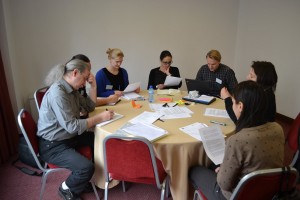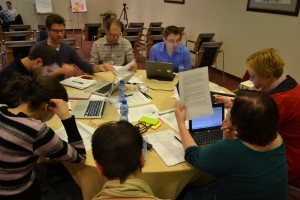Methods
This second workshop (Sofia, Bulgaria, 17 to 19 April 2013) aimed at training practitioners how to select and use the different approaches and methods of (P)TA (“how” question). The assumption guiding the workshop is that the choice of approaches (i.e. classes of methods: expert-based, stakeholder involvement, public consultation) and methods is a complex process, depending on many criteria such as the issue at stake, the type of knowledge relevant for policy-making, the institutional setting in which the project is performed and, last but not least, the political and cultural specificities of the country or region.
The first part of the workshop was dedicated to present and discuss the different TA approaches and methods available and used by the TA community and what they can achieve. Participants then discussed the factors to be considered when selecting an approach and a particular method for a given project. Finally, they exchanged their practices with respect to various approaches and methods.
First day: 17 April
The workshop started by introducing the topic and scope of the workshop:
-
Short presentation of the second workshop and discussion on participants’ expectations
- A TA expert, Danielle Bütschi (TA-SWISS), presented the process leading to method selection for TA projects
-
Three other TA experts, Anders Jacobi, DBT; Mahshid Sotoudeh, ITA; Emiliano Feresin, TA-SWISS made a detailed presentation of 3 case studies and related methods:
-
Anders Jacobi reported about the method Scenario Workshop.
-
Emiliano Feresin reported about the Delphi method.
-
Mahshid Sotoudeh reported about the method Civisti.
-
Second day: 18 April
The second day of the workshop was dedicated to group activities. In the morning four groups composed of 10 practitioners examined different approaches and methods of (P)TA, defining the kind of issues and goals they suit best, discussing their strengths and weaknesses and considering the associated success factors (or quality criteria). In particular there were precise questions to answer:
- Which kind of theme could the method be appropriate/relevant for? – participants could describe actual themes but also generalise the characteristics of a theme (i.e. theme with known risks or theme that stimulates strong public debate, etc.)
- What kind of results and what kind of impacts could the method deliver? – results/impacts could be more or less general (e.g. raise knowledge on the theme/ raise knowledge on the theme for a specific stakeholder group)
- What are the limits of this method? – Limits could be practical (e.g. expensive) or related to the institutional, political or societal context (e.g. for participatory methods: no tradition of participation in the country, no compatibility with the mission of certain science-driven institutions such as academies, etc.)
After this activity, each workgroup presented their results:
In the afternoon a second group activity took place. Opposite to the approach of the morning, this time groups proceeded from problem analysis to method choice. Groups were asked to screen for relevant methods to adopt in a given setting, by means of the website tool www.doingforesight.org. Prerequisite of this activity was the assignment of a setting or frame to the groups, consisting of: A theme or problem (e.g. nanotechnologies); a “story” explaining how the given theme has been discussed; a fictive TA institutional model and background that has to tackle the problem; other conditions that are specific for the project (e.g. budget).
Two groups received an identical setting (A), while the other two groups received another identical setting (B), so that there were two identical couples of groups. Under www.doingforesight.org, the groups had to define the problem, define goals and roles and choose method(s) accordingly. The particular distribution of settings allowed to compare the choices made within each group couple A and B at the end of the activity.
The results were presented afterwards:
Third day, 19 April
In the last day another group activity took place tackling two of the three PACITA example themes: WP5 “European Future Panel on Public Health Genomics”; WP7 “Citizen consultations on Sustainable Consumption”. After a plenary presentation of the two themes, participants split into two groups and discussed in depth each theme with the aim of considering pros and cons of the proposed method. The following key questions guided the discussions:
- What are the pros and cons of the method? Explain what is its added value compared to other ones, what results it can bring and for whom, what are the limits.
- What other methods could be used to complement the one already chosen and why (i.e. for which aim)? Think about which questions cannot be addressed by the chosen method.
- What are the practical factors to consider when implementing the method? Participants should consider factors related to project management, project design, etc. All in all, this discussion is related to the question of “how to meet TA quality criteria?”)
A presentation and discussion on the activity results followed:
The workshop finished in the afternoon with a plenary discussion on what was learnt, what could be improved and possible ideas for the next workshop.





